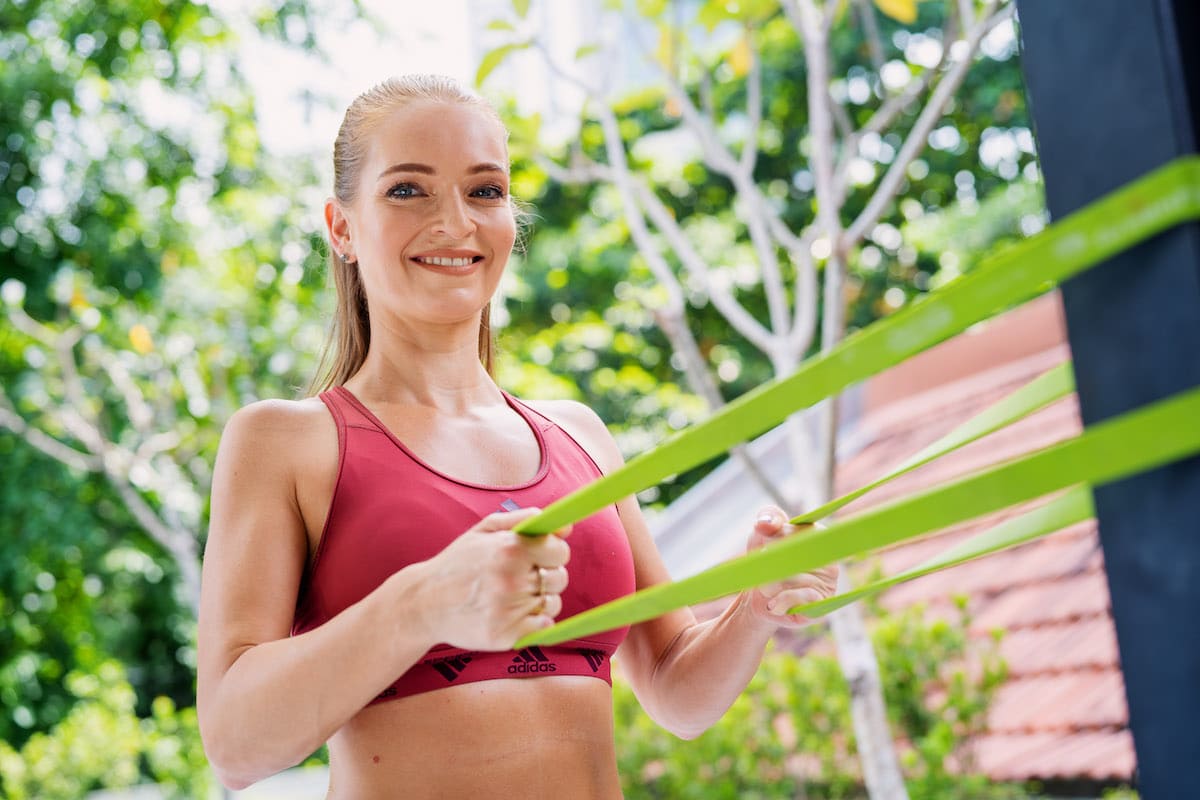Should you be working out on your period? The “time of the month” is a delicate moment for every woman. There are self-care practices, making the space to rest a little bit more, and taking care of your body with nutritious food.
But when it comes to exercising, what’s the consensus? It’s an ongoing topic on the minds of many women. We were never taught if exercise is advisable during our period or not. And we don’t know if there are any consequences if we do.
That’s why we turned to Monique Schuldt, Mindvalley’s 10x Fitness trainer, to give you the best insights on training as a woman during that time of the month.
Getting a better understanding from the experts is a significant first step to taking care of and honoring our bodies. This is where to start.
Why is working out harder on your period?
Female hormones are the number one cause of why working out on your period might feel more difficult. During the menstrual cycle, your infradian rhythm causes you to have less energy and be more emotional.
Moreover, some women experience period cramps (which are caused by the muscles of your uterus contracting), breast soreness, or moments of feeling nauseous.
When it comes to hormone production, a healthy menstrual cycle looks like:
- Menses phase. Your estrogen levels are low and your body eliminates the thickened lining of the uterus.
- Follicular phase. The body produces follicle-stimulating hormone (FSH). This is when estrogen levels slowly rise, which prompts your body to produce another hormone that will lately trigger ovulation.
- Ovulation. The highest rise of estrogen happens during this time of the cycle. Because of this, the pituitary gland will produce a luteinizing hormone to support the release of the ovule towards your uterus.
- Luteal phase. After the egg bursts during ovulation, its follicle remains on the surface of the ovary. It transforms into a structure called corpus luteum, which will trigger progesterone production.
When progesterone levels are high and serotonin levels are low, which happens right before menstruation and the first few days of it, female energy drops to the lowest points. Those are the days when the motivation to work out might be a struggle.
Benefits of working out on your period
Is working out on your period bad? Monique has a simple answer: no. She says, “Scientifically, there is no reason you should skip your workout during your period or you should restrict specific exercises and cannot exercise to the fullest capacity.”
Here are some benefits of working out while on your period:
- Reduced pain, anxiety, and mood swings. During your period, exercise increases the production of endorphins, the “feel good” hormones.
- Reduced PMS symptoms. According to the American College of Obstetricians and Gynecologists, aerobic exercises, for example, can alleviate symptoms of PMS.
- Higher gains in strength and power. Due to lower levels of female hormones, studies like this one showed how the time of your period is a good moment to focus on strength training.
- Boost your energy and combat tiredness. When you feel particularly low in energy, going for a walk, a yoga class, or a short low-impact workout will get you moving and improve blood circulation.
- Regulation of irregular periods. Studies have shown that one factor of irregular periods is physical inactivity. Therefore, make sure to have a regular workout routine adapted to your menstrual cycle to help prevent and treat this condition.
- Reduced bloating. One of the most common symptoms during a woman’s period is bloating (which can be either slight or severe). This symptom can be alleviated through sweating during a workout, paired with a properly nutritious diet.
Monique also strongly advises you to listen to your body and make sure the choices you make are for its optimal gain.
Therefore, if you’re tired and completely depleted of energy, doing a high-intensity interval training (HIIT) workout probably won’t be beneficial. Instead, choose something less intense, like a slow walk in nature or dancing to your favorite songs.
Best workout routines while you’re menstruating
Before diving into any exercise, it’s best to check in with your body. See how it feels in the moment and if it’s up for some movement.
Monique recommends some exercises that can be a good choice during your period:
- Light cardio. Whether it’s going for a walk, running, or swimming (you, brave soul, you), doing some sort of light cardio will get your blood flowing and release endorphins. These exercises don’t put a lot of stress on your body, so they are best done when you feel particularly tired.
- Yoga. It’s been scientifically proven that yoga can help with period pain, especially when you start a few days before the beginning of your period. Yin yoga or hatha yoga for beginners might be the most suitable for this time.
- Pilates. Studies have shown that pilates can reduce the psychological and physical symptoms of PMS. Just like yoga, you can practice it by adjusting to your own pace but you also enjoy a little bit more strength gains when doing pilates exercises.
- Aerobic exercises. Aerobic can be a fun and engaging way to incorporate movement during your menstruation. Not only does it help your body release the “feel-good” hormones, but it could also boost your motivation.
- 10X workout routine. Through a single exercise system, you can have a full-body workout of only 15 minutes, which is suitable for the lighter days of your period. This exercise system will give your body the energy boost it needs in a short but efficient amount of time.
And, of course, rest days are also important. So on the days when the only exercise your body craves is walking to the kitchen for another cup of hot chocolate or fragrant tea, then that, too, will suffice.
Things to keep in mind
While exercising during your period has its benefits, it’s also important to underline a few aspects to keep in mind when engaging in physical activity.
- Don’t go for high-intensity training for long periods of time. In the 10 days before your period and during it, your body is more receptive to strength exercises and flexibility training. Also, this study has found that during menstruation, a high-intensity strenuous exercise routine induces inflammation in the body.
- Supplement with magnesium. It’s advisable to implement it in your routine before and during your menstruation. It relaxes muscle tension and, therefore, helps with period cramps. So, taking a small dose of magnesium during this time will help you have more efficient and pleasant workouts.
- Always remember to listen to your body. Every woman’s body is unique and each cycle can differ from month to month. Stress levels could be higher during some periods when you may not feel like exercising too much. In other cases, you may find the motivation to do a yoga class or a long walk in the park.
- Use a menstrual cup. Heavy periods might be more problematic when you want to exercise, so ditch the pad and try a menstrual cup.
- Avoid inversion yoga poses. In yoga philosophy, menstruation is Apana, meaning the energy is flowing downward. That is why you shouldn’t disrupt the body’s natural energy flow and invert the direction of the energy.
All in all, when you connect to your body’s needs, it means a time full of self-care for it. You’ll soon notice to have a more enjoyable time during the sensitive period of the month.
Let it flow
There’s no reason you should ditch working out during your period. When you’re in touch with your menstrual cycle, you’re better able to support your body with the best food, the proper self-care practices, and the most suitable form of exercise.
Health is always wealth, as they say. And Mindvalley is here to support you on this journey.
In this FREE Masterclass, you can learn how to…
- Better feed your body from leading experts in nutrition
- Take care of your needs from self-care advocates
- Optimize your body’s performance with trainers like Monique Schuldt and Ronan Diego
You’ll be amazed by how aspects of your health can be easily improved with less time and less effort. So let your change do the talking.
Welcome in.









